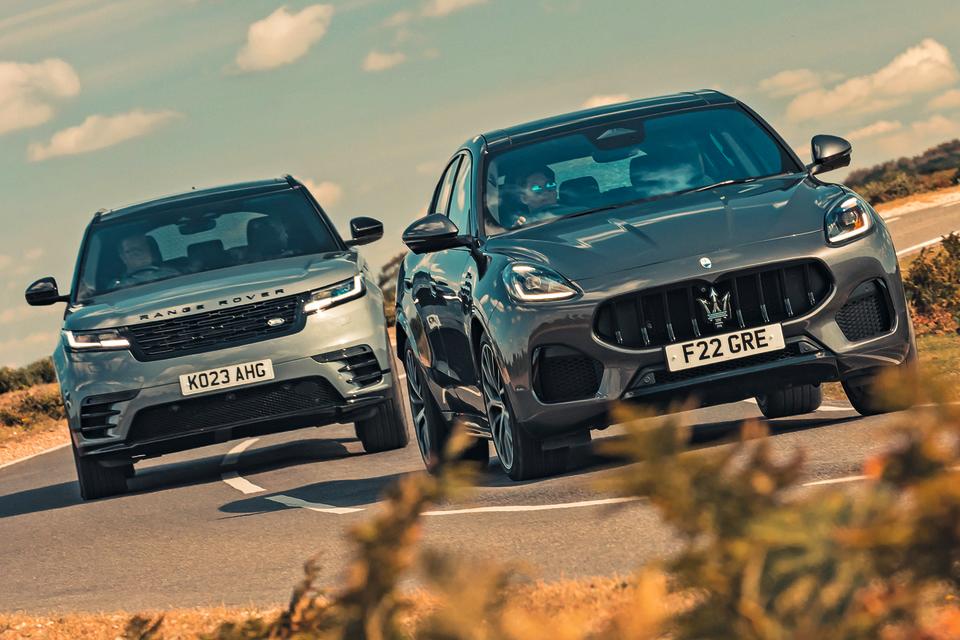Maserati Grecale vs Range Rover Velar: which is the best?

A plug-in hybrid Range Rover Velar or a supercharged Maserati Grecale? Find out which is best...
It’s approaching three years since the formation of the world’s newest automotive power, Stellantis.
At the beginning of 2021, there was some speculation about which hapless, unsuspecting car maker would next be subsumed by this gigantic, marauding and apparently unstoppable industry amoeba (which might well have been an inspiration for the latest series of horror show Stranger Things).
Might it be Jaguar Land Rover, concerned British voices asked?
Might Carlos Tavares (aka The Mind Flayer) see synergy between the Tata Group’s Land Rover, Range Rover and Jaguar brands and his panoply of Stellantis equivalents, of which former Fiat Chrysler Automobiles marque Maserati was one? There we were, caught on his evil tenterhooks, dying to find out.
Well, there were certainly rumours. Like so many, they came to nought. But had things gone differently, the rival mid-sized luxury SUVs that are squaring up on these pages – the Maserati Grecale Modena and the Range Rover Velar P400e – might have been sibling models. In-laws, at the very least.
But which is best? Read on to find out...
Introducing the Maserati Grecale and Range Rover Velar
Quick links: Interior - Powertrains - Driving dynamics - Verdict - Specs
But the above had come to pass, you can bet your silicon-carbide power inverter that we wouldn’t now be looking at such different takes on what technically constitutes a modern petrol-electric hybrid SUV.
Diesel engines may increasingly be becoming a faded memory as electric powertrains grow in prevalence but, as you will no doubt have noticed, the hybrid system is definitely the here-and-now for cars like this.
And if you’re about to adopt one, you might be interested to know whether an intelligently boosted mild-hybrid system, fitted to a lighter SUV like the Grecale, could actually be better to drive than a more powerful and intensively boosted but heavier, plug-in hybrid system in an SUV like the Velar.

More of that in a moment. First, to the chromed bauble that Maserati is newly dangling in front of those who might otherwise buy a Range Rover, Mercedes-Benz or Porsche.
How does the new Maserati, manifested by the Grecale, stand up in the luxury SUV segment of 2023? The Velar, designer darling of this particular set, is undoubtedly the standard by which to judge it.
Maserati Grecale vs Range Rover Velar: interior
Outwardly, I think the Italian has the greater kerbside sparkle. A higher-grade Velar Autobiography might have challenged it but, as well as the slightly lower, curvier silhouette and the more enticing, classic-Maserati brightwork and detailing, there’s just more lustre to the Grecale. Deeper, richer-looking paintwork, greater elegance and flair.
It makes the Velar look slightly bulky, prosaic and ordinary. Inside, the Grecale’s richness and lavishness continue to distinguish it. The Velar’s interior is very nice too, though: higher-waisted and more enveloping, with comfier front seats and better-looking, more intuitive digital technology.

There’s a tidy rigour and calm restraint about the Velar’s interior that’s classy in itself. But the Grecale has the greater material richness by a fair way.
Its glossy carbonfibre-clad consoles, contrast-stitched leather-topped dashboard and bright aluminium pedals and shift paddles couldn’t fail to raise an ‘oooh’ the first time you set eyes on them. And it’s an ‘oooh’ that the plainer-feeling Velar doesn’t quite have an answer to.

Then again, perhaps the Velar doesn’t need one, with so much rational appeal on its side. Because while these cars are separated by less than £1000 on list price, they are technically different beasts.
Maserati Grecale vs Range Rover Velar: powertrains
The Velar is a PHEV with 50kW of DC rapid-charging capability, nearly 15kWh of fitted battery capacity and almost 40 miles of electric-only range, while the Grecale is a mild hybrid with no charging port and no particular tax advantage for fleet drivers and operators.
This, then, is very much a contest for private buyers who are willing to open up their everyday motoring options by opting out of the company car scheme and so wouldn’t pay benefit-in-kind tax on either car. Because if they did, the Velar would be an awful lot cheaper to run.
Yet the Grecale’s mild-hybrid powertrain offers plenty, too. It’s simple and has a particular performance-boosting remit, thanks to a secondary electric supercharger in addition to the belt-driven integrated starter-generator.
So while this isn’t the kind of hybrid system that powers the car all-electrically at low speeds, it’s much lighter than the one in the Velar, and because of that, there’s less than 10bhp per tonne between the cars in power-to-weight terms.

Twenty years ago, I probably wouldn’t have been heard uttering this aloud, but I’m coming to quite like hybrid powertrains. They are generally not hugely exciting, but they are interesting, and working out how to get the best out of them certainly keeps your brain engaged.
Here’s one for the kids. Donkey’s years ago, cars used to come with printed, physical drivers’ handbooks, rather than just QR code links to web pages to scroll through on your grubby smartphone screen. They were wondrous, inky-smelling things – and among their pages could usually be found the optimally efficient cruising speed.
It must have been a pretty simple equation to work out, derived from its gear ratios, its spread of torque and how much aerodynamic drag it had. As I remember, for my A-reg Triumph Acclaim, it was 56mph.

 Yahoo Autos
Yahoo Autos 